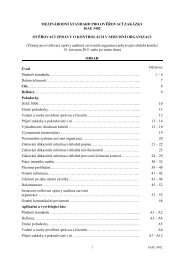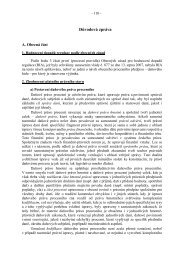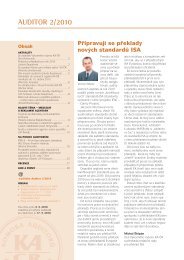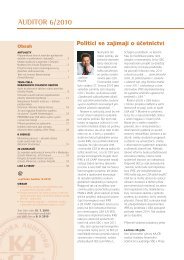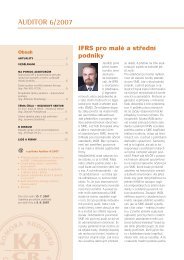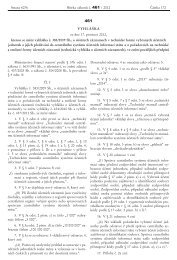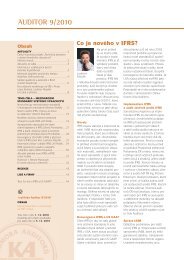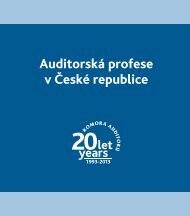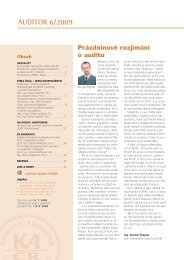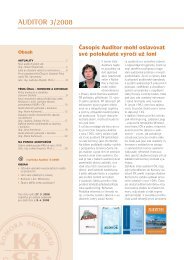Guide to Using International Standards on Auditing in - IFAC
Guide to Using International Standards on Auditing in - IFAC
Guide to Using International Standards on Auditing in - IFAC
You also want an ePaper? Increase the reach of your titles
YUMPU automatically turns print PDFs into web optimized ePapers that Google loves.
31<br />
<str<strong>on</strong>g>Guide</str<strong>on</strong>g> <str<strong>on</strong>g>to</str<strong>on</strong>g> <str<strong>on</strong>g>Us<strong>in</strong>g</str<strong>on</strong>g> <str<strong>on</strong>g>Internati<strong>on</strong>al</str<strong>on</strong>g> <str<strong>on</strong>g>Standards</str<strong>on</strong>g> <strong>on</strong> <strong>Audit<strong>in</strong>g</strong> <strong>in</strong> the Audits of Small- and Medium-Sized Entities Volume 1—Core C<strong>on</strong>cepts<br />
• C<strong>on</strong>ta<strong>in</strong>s the nature, extent, and tim<strong>in</strong>g of specific audit procedures tailored <str<strong>on</strong>g>to</str<strong>on</strong>g> resp<strong>on</strong>d <str<strong>on</strong>g>to</str<strong>on</strong>g> the assessed<br />
risks of material misstatement at the asserti<strong>on</strong> level.<br />
The overall resp<strong>on</strong>ses address assessed risks of material misstatement at the f<strong>in</strong>ancial statement level. Such<br />
resp<strong>on</strong>ses would <strong>in</strong>clude the assignment and supervisi<strong>on</strong> of appropriate pers<strong>on</strong>nel, need for professi<strong>on</strong>al<br />
skepticism, the extent of corroborati<strong>on</strong> required for management’s explanati<strong>on</strong>s/representati<strong>on</strong>s,<br />
c<strong>on</strong>siderati<strong>on</strong> of the audit procedures <str<strong>on</strong>g>to</str<strong>on</strong>g> be performed, and what documentati<strong>on</strong> would be exam<strong>in</strong>ed <strong>in</strong><br />
support of material transacti<strong>on</strong>s.<br />
Further audit procedures generally c<strong>on</strong>sist of substantive procedures such as tests of details, analytical<br />
procedures, and tests of c<strong>on</strong>trols (where there is an expectati<strong>on</strong> that such c<strong>on</strong>trols have been operat<strong>in</strong>g<br />
effectively dur<strong>in</strong>g the period).<br />
Some of the matters the audi<str<strong>on</strong>g>to</str<strong>on</strong>g>r should c<strong>on</strong>sider when plann<strong>in</strong>g the appropriate mix of audit procedures <str<strong>on</strong>g>to</str<strong>on</strong>g><br />
resp<strong>on</strong>d <str<strong>on</strong>g>to</str<strong>on</strong>g> identified risks <strong>in</strong>clude the follow<strong>in</strong>g:<br />
• Use of tests of c<strong>on</strong>trols<br />
– Identify relevant <strong>in</strong>ternal c<strong>on</strong>trols that, if tested, would reduce the need/scope for other<br />
substantive procedures. As a general rule, the sample size for test<strong>in</strong>g c<strong>on</strong>trols is often significantly<br />
less than that of a substantive test of a transacti<strong>on</strong> stream. Assum<strong>in</strong>g that the relevant c<strong>on</strong>trols<br />
operate c<strong>on</strong>sistently and c<strong>on</strong>trol deviati<strong>on</strong>s are unlikely, the use of tests of c<strong>on</strong>trols can often result<br />
<strong>in</strong> less work be<strong>in</strong>g performed. However, there is no requirement that the operat<strong>in</strong>g effectiveness<br />
of <strong>in</strong>ternal c<strong>on</strong>trols (direct or <strong>in</strong>direct) be tested.<br />
– Identify any asserti<strong>on</strong>s that cannot be addressed by substantive procedures al<strong>on</strong>e. For example,<br />
this can often apply <str<strong>on</strong>g>to</str<strong>on</strong>g> completeness of sales <strong>in</strong> a small entity, and situati<strong>on</strong>s where there is highly<br />
au<str<strong>on</strong>g>to</str<strong>on</strong>g>mated process<strong>in</strong>g of transacti<strong>on</strong>s (such as Internet sales) with little or no manual <strong>in</strong>terventi<strong>on</strong>.<br />
• Substantive analytical procedures<br />
These are procedures for which the <str<strong>on</strong>g>to</str<strong>on</strong>g>tal amount of a transacti<strong>on</strong> stream can be reliably predicted based<br />
<strong>on</strong> available evidence. This expectati<strong>on</strong> is compared <str<strong>on</strong>g>to</str<strong>on</strong>g> the actual amount <strong>in</strong> the account<strong>in</strong>g records, and<br />
the extent of any misstatement readily identified (See Volume 1, Chapter 10). In some cases, if the assessed<br />
risk for a particular asserti<strong>on</strong> is low (without c<strong>on</strong>sider<strong>in</strong>g related c<strong>on</strong>trols), the audi<str<strong>on</strong>g>to</str<strong>on</strong>g>r may determ<strong>in</strong>e that<br />
substantive analytical procedures al<strong>on</strong>e would provide sufficient appropriate audit evidence.<br />
• Unpredictability<br />
The need <str<strong>on</strong>g>to</str<strong>on</strong>g> <strong>in</strong>corporate an element of unpredictability <strong>in</strong> procedures performed. A typical example<br />
would be procedures <str<strong>on</strong>g>to</str<strong>on</strong>g> address possible fraud.<br />
• Management override<br />
The need for specific audit procedures <str<strong>on</strong>g>to</str<strong>on</strong>g> address the potential for management override.<br />
• Significant risks<br />
The audit resp<strong>on</strong>se <str<strong>on</strong>g>to</str<strong>on</strong>g> “significant risks” that have been identified. (See Volume 2, Chapter 10.)




